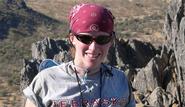
Mary Beth Day '07 (Seneca Falls, NY) has been interested in geology for as long as she can remember. "The intersection of geology and archaeology has long fascinated me," the geoarcheology major explains. As an aspiring paleoclimatology researcher, Day will continue her long-running research of the Great Basin region of Nevada this summer. Under the advisement of Associate Professor of Geology Dave Bailey, she will be working on a research project titled "Chemical Characterization of Lithic Artifact Source Material" as an Emerson grant recipient
Day first became exposed to Great Basin archaeology in a class with Professor of Archaeology Tom Jones during the fall 2004 semester. "This project builds on that knowledge, and provides me with an opportunity to conduct research in my major," Day explains.
Bailey and Jones compiled a database of the chemical signatures of known dacite sources in the Great Basin. Day's research aims to expand this database both chemically and geographically.
With Bailey's and Jones' assistance, Day spent 10 days in Nevada with fellow researcher Will Hoffman '07 (Baltimore, MD) at the beginning of the summer exploring and collecting dacite samples. Now back at Hamilton, she will conduct a detailed chemical analysis of the samples, add this data to that the existing database she already has, and use statistical analysis to determine if they have successfully enlarged the known geographic area or better defined the chemical signature of any dacite sources.
"Ultimately, the information in this database helps tell archaeologists like Professor Jones about the mobility patterns of the paleoindian people," Day explains. "If we analyze the chemistry of dacite artifacts found in the field and are able to match them with a source, we know whoever produced that artifact traveled to that source."
Day is no stranger to Hamilton research; for the last two summers, she has worked in Professor George Shields' computational chemistry lab. She has enjoyed researching at Hamilton; she likes the relaxed atmosphere of the research and getting to enjoy the campus when the weather is nice. She urges students who may be interested in summer research to find a topic they are passionate about and a faculty member with enthusiasm to match.
Day hopes to return to Nevada to continue her research next summer, and is looking into continuing this project for her senior thesis. Her long-term goals include earning a Ph.D. and continuing in a research career in geoarchaeology.
-- by Emily Lemanczyk '05
Day first became exposed to Great Basin archaeology in a class with Professor of Archaeology Tom Jones during the fall 2004 semester. "This project builds on that knowledge, and provides me with an opportunity to conduct research in my major," Day explains.
Bailey and Jones compiled a database of the chemical signatures of known dacite sources in the Great Basin. Day's research aims to expand this database both chemically and geographically.
With Bailey's and Jones' assistance, Day spent 10 days in Nevada with fellow researcher Will Hoffman '07 (Baltimore, MD) at the beginning of the summer exploring and collecting dacite samples. Now back at Hamilton, she will conduct a detailed chemical analysis of the samples, add this data to that the existing database she already has, and use statistical analysis to determine if they have successfully enlarged the known geographic area or better defined the chemical signature of any dacite sources.
"Ultimately, the information in this database helps tell archaeologists like Professor Jones about the mobility patterns of the paleoindian people," Day explains. "If we analyze the chemistry of dacite artifacts found in the field and are able to match them with a source, we know whoever produced that artifact traveled to that source."
Day is no stranger to Hamilton research; for the last two summers, she has worked in Professor George Shields' computational chemistry lab. She has enjoyed researching at Hamilton; she likes the relaxed atmosphere of the research and getting to enjoy the campus when the weather is nice. She urges students who may be interested in summer research to find a topic they are passionate about and a faculty member with enthusiasm to match.
Day hopes to return to Nevada to continue her research next summer, and is looking into continuing this project for her senior thesis. Her long-term goals include earning a Ph.D. and continuing in a research career in geoarchaeology.
-- by Emily Lemanczyk '05
Posted June 24, 2005
